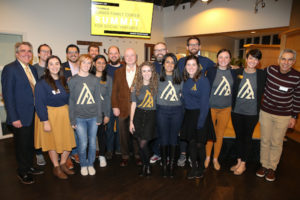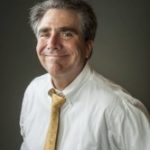In 1969, the Vanderbilt Graduate School of Management burst onto the scene as a purposeful anomaly — a program that not merely dared to be different but celebrated the differences. Over the following three decades, Owen re-modeled itself along more traditional lines, building a school on top of the original foundation that achieved both success and broad respect. By its 40s, it had evolved into an institution that represented the best of both of its traditions: programs that prepared graduates with the skills that employers conventionally expected from top business schools, amid a pragmatically collegial culture that defied convention. Now, it appeared, the school increasingly recognized the value of its distinctive brand — and proudly advertised that distinctiveness to the world.

Students from the inaugural Master of Marketing class
Building on successful launches in the previous decade, Owen continued to expand its offerings and reach new audiences. In 2011, a one-year MAcc Valuation program gave students a pathway with new career options in accountancy. That same year, Owen launched the Americas MBA — an Executive MBA track for students seeking expertise in global business, with an international student cohort and immersions across the Western Hemisphere. Later in the decade, Owen began another one-year master’s program — in Marketing — and partnered with Vanderbilt Law School to offer a new JD/MSF degree.
The school also continued to build on its strengths in health care. The decade saw the launch of the Master of Management in Health Care (MMHC) — an innovative program aimed to equip clinical professionals with the business skills to handle growing responsibilities within their organizations. In 2016, the new Center for Healthcare Markets Innovation opened its doors.

Cal Turner Jr. (center-left in the brown blazer) snaps a group photo with TFC leadership
Similarly, the interest in social entrepreneurship that led to the student-run Pyramid Project now grew into something bigger: the establishment of the Turner Family Center for Social Ventures in 2015. In this new initiative, it was possible to hear distant echoes from Owen’s past — the aim to apply business knowledge to remediate poverty and other societal ills.
Following some slippage in the rankings, Owen regained an elite spot under Bradford’s leadership and maintained it. In his final year as dean, the school was rated first in the world for diversity of recruiters — and tenth in faculty quality and in educational experience.
That pattern continued under Eric Johnson, who became dean in 2013. The following year, U.S. News & World Report noted that, among those in the top 25, Owen students enjoyed the ninth-highest rate of employment at graduation. The school went on to earn its highest rankings ever from U.S. News and The Economist.
Rankings and accolades, of course, never came close to representing the whole story of the school. But for prospective students who apply rankings as a filter in their school searches, a consistently strong position gave Owen the opportunity to tell its distinctive story to a broader audience that was ready to listen.
Johnson was particularly suited to tell that story. After joining the Owen faculty in 1991, he became one of the youngest professors to receive tenure in the school’s history. When he returned to Vanderbilt after 14 years at Dartmouth —where he was responsible for the Tuck School’s top-rated MBA program and research centers — he brought a deep appreciation of Owen’s brand.

Dean M. Eric Johnson
Many of the qualities that appealed so strongly to later generations of Owen students had been baked into the original educational experiment: the fixed, small size; the work in teams; the focus on experiential learning; students’ freedom to shape their own learning experience; the strong sense of community in a place where students and professors are on a first-name basis; the commitment to diversity; and, especially, the collegiality among students. (Even the beloved “Closing Bell” gatherings on Thursdays, when the community feel is perhaps most evident, grew from a tradition that began informally in those early days.) All of these attributes, Johnson notes, were “pretty revolutionary at the time.”
Many still were. Now, they were also revelatory for students in search of a highly ranked school that also offered a supportive community. The school’s brand position, which leveraged the value of the Vanderbilt name, was capsulized in a 136-word manifesto. It spoke of a school that is “competitive, not cutthroat; a culture where people “lead with ideas, not egos” and a “b-school built for the persistent, the genuine, the professional who knows he or she hasn’t heard it all before, and uses that humility to grow.” Johnson honed the message to its essence: world-class business education on a personal scale.
The personal scale had always been there. The global recognition of excellence had not. In a sense, then, Owen began its second half-century remarkably far from where it had started, yet resolutely standing in the distinctive spot it originally claimed.